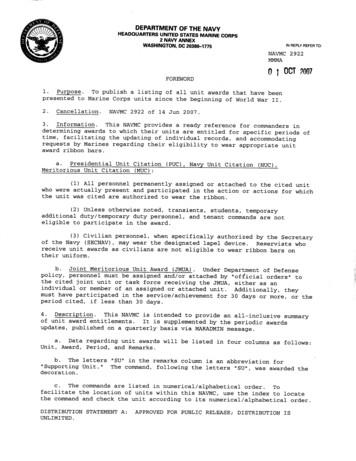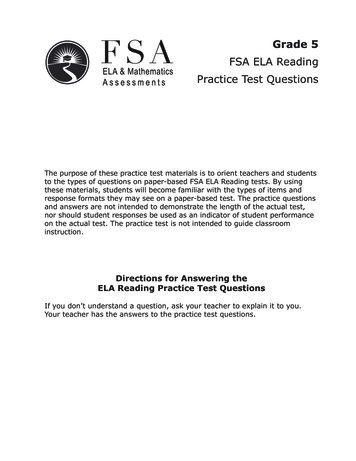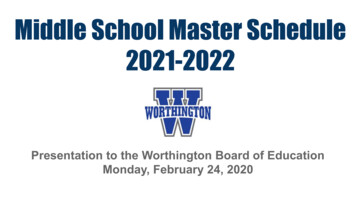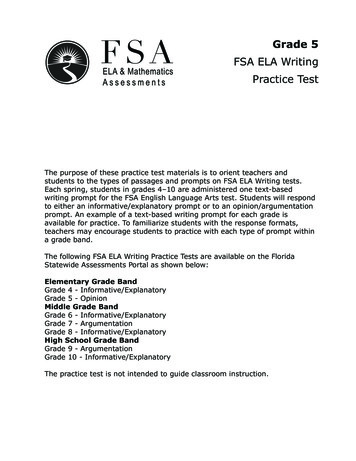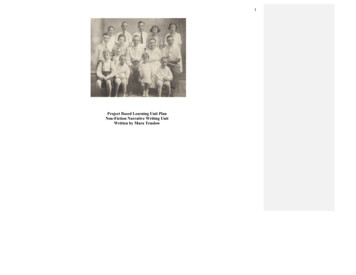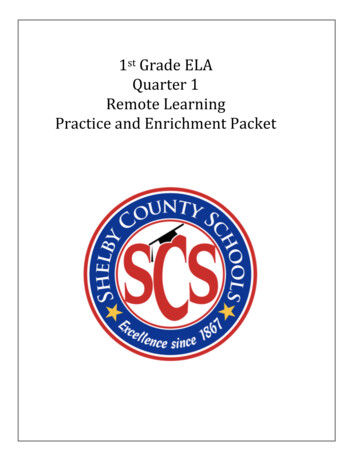
Transcription
1st Grade ELAQuarter 1Remote LearningPractice and Enrichment Packet
Hello SCS Family,This resource packet was designed to provide students with activities, which can becompleted at home independently, or with the guidance and supervision of familymembers or other adults. The activities are aligned to the TN Academic Standards for ELAand will provide additional practice opportunities for students to develop and demonstratetheir knowledge and understanding.A suggested pacing guide is included; however, students can complete the activities in anyorder over the course of several days. Below is a table of contents, which lists each activity.Table of ContentsSECTION ILiteracy Project: My Very Own MachineSECTION IIPractice Pages (Grouped by Instructional Week)Start Smart Week 1Start Smart Week 2Start Smart Week 3Unit 1 Week 1Unit 1 Week 2Unit 1 Week 3Unit 1 Week 4Unit 1 Week 5Unit 1 Week 6
Literacy Project1st Grade Literacy Project: My Very Own MachineEstimated TimeApproximately 5 days of 45-minute activities.1.RL.KID.1/1.RI.KID.1 Ask and answer questions about key details in a text.Grade Level Standard(s) 1.RL.KID.2 Identify the main topic and retell key details of a text.1.W.TTP.2 Write informative/explanatory texts in which they name a topic,supply some facts about the topic, and provide some sense ofclosure.To build more background about the project’s topic,help your childaccess online books and videos about simple machines and inventions.BooksThe Most Magnificent Thing by Ashley Spireshttps://www.youtube.com/watch?v UM8oN4yzJqwHave You Thanked an Inventor Today? by Patrice McLaurinhttps://www.youtube.com/watch?v Dcwvzg07PUYSimple Machines by Allan Fowlerhttps://www.youtube.com/watch?v n-BpBJLwA2cCaregiver SupportOptionVideoSuper Simple Machineshttps://www.youtube.com/watch?v lueqE0lxLycSimple Machines Songhttps://www.youtube.com/watch?v 0FkSjINrrI&pbjreload 101Reading:Read or review virtually the books listed above. Use the questions foundvia the link below to help ensure your child understood what was read.Encourage your child to respond orally to the questions first. Then selectquestions to have them write a response to as well.
Questions to Support Reading Comprehension:https://bit.ly/3k7aWtPWriting:During the writing process of the project outlined below, please encourageyour child to sound out words and try their best to write a sentence. Don’tworry about correcting spelling. Inventive spelling is appropriate at this age.You can help write words for your child after encouraging them to try ontheir own.Materials NeededQuestion to ExplorePencil, Glue, Tape or Stapler and Coloring Materials (crayons, markers,etc.), access to online books and videosWhat machines do you enjoy using now?What is something you currently do that you wish was less difficult?Student DirectionsWhat would make a task easier for you to complete?For this project, you will create plans to design a machine thatwould make completing a current task easier. You will be creativeand decide on a machine that does not already exist. Oncecomplete, you will discuss ways that your newly designed machinecould become a reality.Building BackgroundActivity 1: Read About It! Read or show virtually the books and video noted in the outline inorder to help build background knowledge about machines and inventors. Use thequestions found via the link below to help your child think through the texts.Questions to Support Reading Ve3uzqaugzbJtXA29vy7jjDOIYp49/view?usp sharingPlanningActivity 2: Imagine It! Think about something that you currently have to do that you wishwere easier. Some ideas include doing your homework, washing dishes, cleaning yourbedroom, etc.A. What would you need to make that task easier to complete? If you had to invent amachine to make that task easier, what would it look like? Think of something that doesnot already exist.B. Create a name for your machine and draw a picture of it on the next page. Add as many
details as possible. Label each component of your machine using words.My Machine
Describe ItActivity 3: Now that you’ve shown what your machine looks like, use complete sentenceswith space between your words, correct capitalization and punctuation marks. Addillustrations to each page for more visual details.A. Use the spce to detail the specifics of your machine. Decide wht it does exactly.What kind of machine is it? What does it do? How does it work? What does it looklike?What kind of machine is this? What does it do? For Example: My machine is a vacuum thatcleans up my clothes from the floor.
What does it look like? For example: It is a small hand-held circular object made out of redplastic.How do you get your invention to work? For example: Press the green button and say theword clean.
Putting it TogetherActivity 4: Book CreationA. Combine your work to create a My Very Own Machine Book using glue, tape, and or astapler to bind your pages. Add any final coloring and decorating to your new book. Becreative!B. Share your work with a family member by reading it aloud and explaining your veryown machine. (Parents if possible allow your child to try and create their machine.)In ReflectionActivity 5: ReflectionA. How did you feel planning and designing your very own invention? Do you think it could becreated in real life? Talk to a grown up about what you would need to get it created.B. Record your thoughts and feeling on the lines below or on your own paper. Be proud ofyourself and your work!
Start Smart Week 1Practice PagesTThis section includes pages S2, S4, S9, S11, and S15 ONLY.
Phonemic Awareness: Phoneme IdentityName61.2.3.Teacher Directions: Model item 1 by saying /s/ /a/ /d/. I will blend the sounds to make a word: /sssaaad/, sad. Thensay mat and six. Stress the /s/ and /m/ beginning sounds. Say: The words sad and six have the same beginning sound:/s/. Mat has a different beginning sound: /m/. Guide children to circle the pictures for sad and six. For items 2–3, saythe following sounds. Have students blend the sounds to say each word. Then have them circle the two pictures ofwords that have the same beginning sound. 2. /m/ /i/ /t/, /m/ /e/ /n/, /s/ /i/ /t/; 3. /m/ /ü/ /n/, /s/ /ü/ /p/, /s/ /u//n/.SS2Grade 1 Start Smart Week 1Copyright McGraw-Hill Education. Permission is granted to reproduce for classroom use.Say each picture name out loud. Circle the two picturesof words that have the same beginning sound.
Phonics: /a/aNameB. Say each picture name. Write a to completethe words.hfSS4tnGrade 1 Start Smart Week 1Copyright McGraw-Hill Education. Permission is granted to reproduce for classroom use.A. Say each picture name. Write a below thepicture if its name begins with a as in apple.
Handwriting: Mm, Ss, AaNameCopyright McGraw-Hill Education. Permission is granted to reproduce for classroom use.Trace and write the letters. Write neatly.MmMmMmU u MmUuMmUu Uu Uu UuSsSsSsUuSsUuSsUuSsUu Uu Uu UuAaAaUu AaUuUu Uu Uu UuAaWrite a sentence. Leave spaces between the words.Grade 1 Start Smart Week 1SS9
Phonics: /r/r, /n/nNameCopyright McGraw-Hill Education. Permission is granted to reproduce for classroom use.A. Say each picture name. Write n below thepicture if its name begins like nest. Write r ifits name begins like rat.B. Say each picture name. Then write n below thepicture if its name ends like fun.Grade 1 Start Smart Week 1SS11
Phonics: /i/iNameCopyright McGraw-Hill Education. Permission is granted to reproduce for classroom use.A. Say each picture name. Write i below the pictureif its name begins with i as in ink.B. Say each picture name. Write i to completethe words.spxgGrade 1 Start Smart Week 1SS15
Start Smart Week 2Practice PagesThis section includes pages S16, S17, S18, S20, and S25 ONLY.
Phonological Awareness: Syllable SegmentationNameSay the name of each picture. Count the syllables in eachword. Then draw an X in one box for each syllable.Copyright McGraw-Hill Education. Permission is granted to reproduce for classroom use.1.2.3.4.Teacher Directions: Model item 1 by saying the word book. Say: I can clap the syllables, or word parts, I hear. Theword book has one syllable: book. Clap the syllables with me: book. You clapped one time because book has onesyllable.Grade 1 Start Smart Week 2SS17
Phonemic Awareness: Phoneme IsolationNameSay each picture name. Say the middle sounds.Circle the picture whose name has the samemiddle sound as the first picture in the row.Copyright McGraw-Hill Education. Permission is granted to reproduce for classroom use.1.2.3.Teacher Directions: Model item 1 by saying /b/ /a/ /g/. Emphasize the middle sound. Then say map and bed andexplicitly compare middle sounds. Say: The words bag and map have the same middle sound: /a/. Bed has a differentmiddle sound: /e/. Guide children to circle the picture of the map.SS18Grade 1 Start Smart Week 2
Phonics: /o/oNameB. Say each picture name. Write o to completethe words.xbSS20xGrade 1 Start Smart Week 2Copyright McGraw-Hill Education. Permission is granted to reproduce for classroom use.A. Say each picture name. Write o below the pictureif its name begins with o as in ox.
Handwriting: Cc, Ff, OoNameCopyright McGraw-Hill Education. Permission is granted to reproduce for classroom use.Trace and write the letters. Write neatly.Cc CcCc CcCcCcCcCcCc Cc Cc CcFfFfFfFf FfFf FfFfFfFf Ff Ff FfOoOoOo OoOoOoOo Er Er ErWrite a sentence. Leave spaces between the words.Grade 1 Start Smart Week 2SS23
Phonics: /e/eNameCopyright McGraw-Hill Education. Permission is granted to reproduce for classroom use.A. Say each picture name. Write e below the pictureif its name begins with e as in egg.B. Say the picture name. Then write e to completethe word. Read the word.lgGrade 1 Start Smart Week 2SS25
Start Smart Week 3Practice PagesThis section includes pages S32, S33, S34, S37, and S38 ONLY.
Phonemic Awareness: Phoneme SegmentationNameCopyright McGraw-Hill Education. Permission is granted to reproduce for classroom use.Say the name of each picture. Count the sounds in eachword. Then draw an X in one box for each sound.Teacher Directions: Model item 1 by saying egg. Say: I can say the sounds in the word egg. The word egg has twosounds: /e/ /g/. Say the sounds with me: /e/ /g/.SS32Grade 1 Start Smart Week 3
Phonics: /k/k, /k/ckNameCopyright McGraw-Hill Education. Permission is granted to reproduce for classroom use.A. Say each picture name. Write k below thepicture if its name begins like king.B. Say each picture name. Write ck below thepicture if its name ends like back.C. Write the letters ck to make new words.kisoGrade 1 Start Smart Week 3SS33
Phonics: /u/uNameB. Say the picture name. Then write u to complete theword. Read the word.cSS34Grade 1 Start Smart Week 3pCopyright McGraw-Hill Education. Permission is granted to reproduce for classroom use.A. Say each picture name. Write u below the pictureif its name begins with u as in up.
Handwriting: Kk, Uu, GgNameCopyright McGraw-Hill Education. Permission is granted to reproduce for classroom use.Trace and write the letters. Write neatly.KK 1kkKK kk KK kk KK kkKK kk K k K k K kUU uuUuUu UuUu UuUuUuUu Uu Uu UuGgGgGg GgGgGg Gg Gg GgGgWrite a sentence. Leave spaces between the words.Grade 1 Start Smart Week 3SS37
Handwriting: Qq, Jj, Yy, ZzNameQqQqQqQq QqQqQq Qq Qq QqQqJjJj JjJj JjJjJjJjJj Jj Jj JjYyYy YyYy YyYyYyYyYy Yy Yy YyZzZZ zzZz ZzZz ZzZzZzZz Zz Zz ZzSS44Grade 1 Start Smart Week 3Copyright McGraw-Hill Education. Permission is granted to reproduce for classroom use.Trace and write the letters. Write neatly.
Unit 1 Week 1Practice PagesThis section includes pages 4, 6, 9, 11, and 12 ONLY.
Phonics: Short aNameA. Read the words in the box. Write the word that namesthe picture.batcanhatpanCopyright McGraw-Hill Education. Permission is granted to reproduce for classroom use.1.2.3.4.B. Change one letter to make a new word with the shorta sound. Then write the word.1. men4Grade 1 Unit 1 Week 12. fin
Spelling: Short aNameA. Read the words in the box. Then sort the words usingthe word endings.cannaphatWords with antapcatWords with atCopyright McGraw-Hill Education. Permission is granted to reproduce for classroom use.Words with apmanB. Think of words that have the same word endings.Add them to the chart.6Grade 1 Unit 1 Week 1
Structural Analysis: Inflectional Ending -sNameAdd -s to an action word when it follows a name orthe words he, she, or it. Read the words. Listen for thesounds at the end of naps.Copyright McGraw-Hill Education. Permission is granted to reproduce for classroom use.I nap.He naps.Pam naps.Circle the word that completes each sentence.Then write the word. Read the sentences.1. It.quackquacks2. Maxfor school.packpacks3. He.batbatsGrade 1 Unit 1 Week 19
High-Frequency WordsNameA. Read and spell each word in the box. Complete eachsentence. Use one of the words in the box.doesCopyright McGraw-Hill Education. Permission is granted to reproduce for classroom use.1. I like my2. Where3. Sam can4.notschoolwhat.Nan go?see the map.do the cats have?B. Write your own sentence using a word from the box.Teacher Directions: Point to the word does. Use the Read/Spell/Write routine. Repeat for each word in the box.Grade 1 Unit 1 Week 111
Grammar: SentencesNameA sentence is a group of words that tells a whole idea.A sentence begins with a capital letter.Example: Nat can go.1. Sam has a hat.2. like to.3. We ran and ran.4. can see.5. Pam has a bag.6. Nan can play.7. A cat.B. Add words to make this a sentence.Write the sentence.1.12can hop.Grade 1 Unit 1 Week 1Copyright McGraw-Hill Education. Permission is granted to reproduce for classroom use.A. Circle the sentences.
Unit 1 Week 2Practice PagesThis section includes pages 19, 20, 22, 25, and 28 ONLY.
Phonics: Short iNameThe letter i stands for the short i soundyou hear in pin.Copyright McGraw-Hill Education. Permission is granted to reproduce for classroom use.Read the word. Listen for the short i sound. Circle thepicture that the word names.1. hill2. pig3. fin4. lidGrade 1 Unit 1 Week 219
Phonics: Short iNameA. Read the words in the box. Write the word that namesthe picture.kisspinpickdigwin2.3.B. Change one letter to make a new word with the short isound. Then write the word.1. bag2. hat3. fan4. pack20Grade 1 Unit 1 Week 2Copyright McGraw-Hill Education. Permission is granted to reproduce for classroom use.1.
Spelling: Short iNameA. Read the words in the box. Then sort the words usingthe word endings.hitkissmissWords with itsitwinWords with inCopyright McGraw-Hill Education. Permission is granted to reproduce for classroom use.Words with isspinB. Think of words that have the same word endings. Addthem to the chart.22Grade 1 Unit 1 Week 2
Structural Analysis: Double Final ConsonantsNameWhen a word ends with two consonants that are thesame, the letters together make one sound.Copyright McGraw-Hill Education. Permission is granted to reproduce for classroom use.willjazzpassRead each sentence. Underline the word that endswith the same two consonants. Write the word onthe line.1. Cam will hit.2. Dan can pass.3. Matt has a big hat.4. Pam has to miss school.Grade 1 Unit 1 Week 225
Grammar: Word OrderNameThe words in a sentence must be in theright order.The order must make sense.Correct: Tim has a tan cap.A. Circle the sentences that have the words in theright order.1. tag can Dan play.2. Bill can go here.3. cat hid The bag in a.4. Sam is a big pig.5. Sid and Pat can go.B. Write your own sentence. Check that your wordsare in the right order from left to right.28Grade 1 Unit 1 Week 2Copyright McGraw-Hill Education. Permission is granted to reproduce for classroom use.Not correct: cap a has Tim tan.
Unit 1 Week 3Practice PagesThis section includes pages 35, 36, 38, 41, and 42 ONLY.
Phonics: l-BlendsNameSometimes consonants form a blend. You can hear thesound of a consonant and letter l form a blend at thebeginning of glad and slim.Copyright McGraw-Hill Education. Permission is granted to reproduce for classroom use.Read the word. Draw a line under the letters thatform a blend. Write the letters. Circle the picture.1. flag2. clip3. slip4. clamGrade 1 Unit 1 Week 335
Phonics: l-BlendsNameA. Read each word in the box. Use a word from the boxto complete each sentence.flag1. We areslamblack.2. Matt and Kim3. Do notglad.the door!4. I can see a.B. Add one letter to make a new word with a blend.Then write the word.1. back36Grade 1 Unit 1 Week 32. sipCopyright McGraw-Hill Education. Permission is granted to reproduce for classroom use.clap
Spelling: l-BlendsNameA. Read the words in the box. Then sort the words.clipflagflipWords with clWords with blWords with flWords with slplanslipWords with plB. Think of words that have the same word blends.Add them to the chart.38Grade 1 Unit 1 Week 3Copyright McGraw-Hill Education. Permission is granted to reproduce for classroom use.black
Structural Analysis: Plural Nouns with -sNameSome words end with s. When a word ends in ones, it means there is more than one of something.Copyright McGraw-Hill Education. Permission is granted to reproduce for classroom use.flagflagsRead each sentence. Underline the word that tellsabout more than one thing. Write the word on the line.1. See the hats?2. The fish has fins.3. We have cats.4. Tim and Jim have six bats.Grade 1 Unit 1 Week 341
Structural Analysis: Plural Nouns with -sNameA. Read the sentences out loud. Circle the wordthat completes each sentence. Use the picturesto help you.2. Pam has a (bat, bats)3. He has (hat, hats).B. Use one of the words you circled to write your ownsentence.42Grade 1 Unit 1 Week 3Copyright McGraw-Hill Education. Permission is granted to reproduce for classroom use.1. There is a (pin, pins).
Unit 1 Week 4Practice PagesThis section includes pages 49, 50, 51, 54, and 60 ONLY.
Phonemic Awareness: Phoneme CategorizationNameSay each picture name and the sound that ends it.Circle the picture in each row whose name doesNOT end with the same sound as the other two.Copyright McGraw-Hill Education. Permission is granted to reproduce for classroom use.1.2.3.4.5.Teacher Directions: Model item 1 by saying pin, ten, and pig. Repeat, stressing the difference between the /n/ and/g/ ending sounds. Say: The words pin and ten have the same ending sound: /n/. Pig has a different ending sound: /g/.Guide children to circle the picture of the pig.Grade 1 Unit 1 Week 449
Phonemic Awareness: Phoneme SegmentationNameSay the name of each picture. Count the sounds in theword. Draw an X in one box for each sound.1.Copyright McGraw-Hill Education. Permission is granted to reproduce for classroom use.2.3.4.5.Teacher Directions: Model item 1 by saying egg. Say: I can say the sounds in the word egg. The word egg has twosounds: /e/ /g/. Say the sounds with me: /e/ /g/. Guide children to draw two X’s for item 1.50Grade 1 Unit 1 Week 4
Phonics: Short oNameThe letter o stands for the short o sound youhear in sock and dot.Copyright McGraw-Hill Education. Permission is granted to reproduce for classroom use.A. Read the words in the box. Listen for the short osound. Write the word that names each picture.mophopclock1.2.3.4.boxB. Circle and write each word that has the short o sound.5. canmomclip6. finmattopGrade 1 Unit 1 Week 451
Spelling: Short oNameA. Read the words in the box. Then sort the words usingthe word endings.hoghoplogWords with otlottopWords with opCopyright McGraw-Hill Education. Permission is granted to reproduce for classroom use.Words with oghotB. Think of words that have the same word endings.Add them to the chart.54Grade 1 Unit 1 Week 4
Grammar: Questions and ExclamationsNameA question is a sentence that asks something. It endswith a question mark. Example: Can Pal run?An exclamation is a sentence thatshows strong feelings.It ends with an exclamation mark.Read each sentence. If it is a question, add a questionmark. If it is an exclamation, add an exclamation mark.1. Can Jon kick it2. He can kick3. Lin ran, too4. Did they go60Grade 1 Unit 1 Week 4Copyright McGraw-Hill Education. Permission is granted to reproduce for classroom use.Example: Pal can run!
Unit 1 Week 5Practice PagesThis section includes pages 67, 70, 73, 74, and 78 ONLY.
Phonics: r-blends and s-blendsNameSome words begin with a consonant blend. Listen tothe beginning sounds in the word crab. You can hearthe sound of each letter in the blend.Copyright McGraw-Hill Education. Permission is granted to reproduce for classroom use.Read the word. Write the word. Circle the picturethat it names.1. frog2. snap3. crib4. grassGrade 1 Unit 1 Week 567
Spelling: r-blends and s-blendsNameA. Read the words in the box. Then sort the words usingthe word blends.spingrassdropWords with spspilldripWords with grCopyright McGraw-Hill Education. Permission is granted to reproduce for classroom use.Words with drgrabB. Think of words that have the same word blends.Add them to the chart.70Grade 1 Unit 1 Week 5
Structural Analysis: PossessivesNameAn ’s at the end of a naming word means thatsomething belongs to that person or thing.Copyright McGraw-Hill Education. Permission is granted to reproduce for classroom use.Matt’s hatA. Read the sentences. Underline the word that tells thatsomething belongs to a person or thing. Write the word.1. Dan’s cat is little.2. This is my cat’s mat.3. Pam’s pals play.B. Write a sentence using a word with ’s.Grade 1 Unit 1 Week 573
Structural Analysis: PossessivesNameA. Circle the word that completes each sentence.1. The (dogs, dog’s) play.2. The (girls, girl’s) dress is pink.4. The (boys, boy’s) hat is red.5. (Frans, Fran’s) doll is on the bed.B. Use one of the words you circled above to write a newsentence.74Grade 1 Unit 1 Week 5Copyright McGraw-Hill Education. Permission is granted to reproduce for classroom use.3. The (birds, bird’s) are in the tree.
Mechanics: Capitalization and PunctuationNameBegin every sentence with a capital letter.Unscramble the words in the box to complete eachsentence. Write the sentence in order.Start with a capital letter and usethe correct mark at the end.1. Nat swim can here2. did have fun Nat3. look Nat at go78Grade 1 Unit 1 Week 5Copyright McGraw-Hill Education. Permission is granted to reproduce for classroom use.End every sentence with a punctuation mark.
Unit 1 Week 6Practice PagesThere are no practice pages for week 6. This is because week 6 is dedicatedto reviewing and extending. Therefore, during week six students shouldensure they have completed both their literacy project(s) and practicepages.
¾ Start Smart Week 1 ¾ Start Smart Week 2 ¾ Start Smart Week 3 ¾ Unit 1 Week 1 ¾ Unit 1 Week 2 ¾ Unit 1 Week 3 . access online books and videos about simple machines and inventions. Books x The Most Magnificent Thing by Ashley Spires . Phonics: /k/k, /k/ck Grade 1 Start Smart
